His Holiness the Dalai Lama Travels from Oslo to Rotterdam
11/05/2014 14:30 (GMT+7) Font size:  
Rotterdam, Holland, 10 May 2014 - The streets of Oslo were quiet and sun shone as His Holiness the Dalai Lama left to drive to the airport to fly to Rotterdam. In contrast, the weather in Rotterdam when he arrived was cold and wet. However, his Tibetan and Dutch hosts were warm in their welcome and accompanied him to a short meeting with the media. His Holiness told the assembled journalists how happy he was to be in Holland again, the land of fine people and beautiful tulips. He gave a summary account of his three commitments, telling them of his efforts to promote human values based on love and affection, his interest in fostering inter-religious harmony and in preserving Tibet’s culture of peace and compassion, as well as the delicate environment of the Roof of the World
The first question was about how things have been in Tibet since His Holiness was last in Holland. He replied that hardline officials continue to target Tibetan language and religion as posing a threat of separatism and have continued to restrict them. The second question enquired how long Tibetans could be expected to remain non-violent and His Holiness answered that if Tibetan Buddhist culture is damaged in Tibet, who knows what will happen.
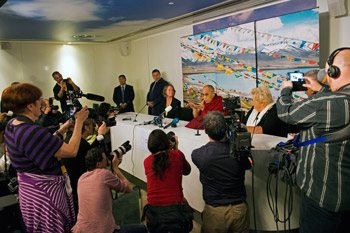 | His Holiness the Dalai Lama meeting members of the press on his arrival in Rotterdam, Holland on May 10, 2014.
Photo/Jurjen Donkers |
A journalist who writes on religious affairs said that demonstrations by pro-Shugden supporters are expected and asked what His Holiness considers to be bad about the practice. He responded:
“We’re Buddhists and the Buddha advised us not to take refuge in ordinary deities and spirits. This is a basic Buddhist principle. The Shugden followers as good as take refuge in that spirit. The spirit arose in the 17th century at the time of the 5th Dalai Lama. He wrote that it was a harmful, evil spirit. One of its harmful aspects is a strident sectarianism, whereas I am committed to an inclusive non-sectarianism. Because of this spirit, people have destroyed the images and scriptures of other traditions, particularly the Nyingmapas.
“I started to propitiate it out of ignorance in 1951 and did so until 1970 when I realised there were complications with it which prompted me to investigate it. I have 20 teachers from various traditions and all but one opposed this practice. After I stopped doing it in the early 70s people gradually got to know about it and I explained why.
“Normally we would expect the spirit to be protecting people, but in this case there are people trying to protect the spirit. They shout: “Stop lying,” but I don’t know what they think anyone is lying about. It’s my duty to let people know about this. The demonstrators say I’ve banned this practice, but that’s not so, I haven’t and the monasteries associated with Shugden in South India are evidence of this.”
After lunch in Rotterdam, His Holiness visited the Wereldmuseum where he was requested to consecrate the remarkable collection of Tibetan artefacts set up as a chapel by the Bodhimanda Foundation established by the Verhoeven family. His Holiness advised that it would be more appropriate to set an image of the Buddha in the predominant position, because Buddhists take refuge in the Buddha, Dharma and Sangha. No matter how important a Dalai Lama may have been he was still only a member of the Sangha. In response to a request, His Holiness named the chapel Chökhorling.
In the church of Laurenskerk, His Holiness addressed about 2000 Tibetans who live in the Nordic countries. Looking out over a sea of Tibetan faces, he began:
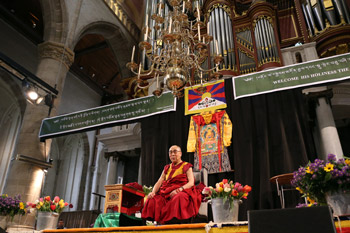
| His Holiness the Dalai Lama speaking to members of the Tibetan community living in Nordic countries at the church of Laurenskerk in Rotterdam, Holland on May 10, 2014. Photo/Jeppe Schilder
|
“Those of us from the Roof of the World, who have a close relationship with Avalokiteshvara, have been going through difficult times. You’ve come from all over Europe to see me and I greet you all. We’ve all faced ups and downs. Since I was 25 until now when I’m nearly 79, I’ve lived as a refugee. But there is something about us Tibetans that the greater the difficulties we face, the tougher is our determination. The spirit of the people in Tibet is very strong; their courage is amazing. And they remain non-violent. We retain a strong dedication to our religion and culture and because of aspirations we have made in the past, we have not let our heritage down. After 60 years the issue of Tibet is still alive. Awareness of Tibet is still growing.”
He said that according to a survey conducted in China about four years ago, there were 300 million Buddhists in China, most of them educated people. His Holiness has met about 10,000 Chinese intellectuals and learned of their interest in Tibetan Buddhism. In Japan too, there is growing interest in Tibetan Buddhism. One Japanese Abbot told him that although recitation of the ‘Heart Sutra’ is widespread in Japan, few people understand what it means and they value the explanation provided by the Tibetan tradition.
His Holiness remarked that modern science has much to teach Tibetans, but modern scientists are also showing interest in the knowledge of mind and emotions Tibetan Buddhism preserves from the Indian tradition.
“If we had remained in Tibet, we would not have learned what we have learned, nor would we have had the same opportunities to share with others what we know.”
He commented that more and more ordinary people are studying and even in monasteries previously dedicated to performing rituals, study programmes have begun. As well as in Gelug institutions, amongst Sakyapas and Nyingmapas there is a growing dedication to studying Buddhism’s classic philosophical texts and this is in turn influencing the monasteries in Tibet. Nuns too have been given opportunities and encouragement to study and some among them are now in the process of taking exams for a Geshe-ma degree.
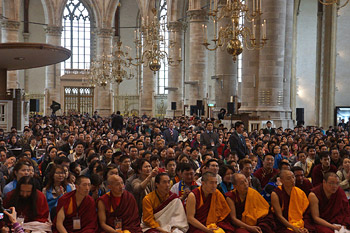
| More than 2000 members of the Tibetan community living in Nordic countries listening to His Holiness the Dalai Lama speaking at the church of Laurenskerk in Rotterdam, Holland on May 10, 2014. Photo/Jeremy Russell/OHHDL
|
“When I visited the Bandhara settlement in Madya Pradesh students from the Tibetan school gave a demonstration of their debating skills. Their teacher was a nun who came from Tibet in1990 and had trained and studied hard at Dolma Ling Nunnery. Now she is teaching others and I praised her achievements. In Ladakh and other parts of the Himalayan region lay people are setting up study groups.”
Looking back over the development of Tibetan education, His Holiness said that he and others arrived in India in April 1959 and by March 1960 the first schools had begun. They asked Prime Minister Nehru for help in setting up these schools and took his advice to make English the medium of instruction. He mentioned a Tibetan he had just met in Norway who was born in Tibet but has gone on to University and is about to complete his PhD. He commended such expertise as something for other Tibetans to aim for.
Expressing surprise at hearing that some Tibetan families in the West speak only English at home, His Holiness mentioned the Tibetan Muslims he met recently in Srinagar, Kashmir, whose children speak beautiful Tibetan. There is no Tibetan instruction in their school but their parents and grandparents have taught them.
Translations from Sanskrit of texts concerning Buddhist logic and epistemology are now only available in Tibetan. It is training in these skills that has allowed Tibetans to engage so readily in the study of modern science.
“Last year in New York,” His Holiness recalled, “I met a group of Chinese writers, two of whom had come from Beijing. They told me that as far as ethics is concerned China is currently at the lowest point in its 5000 year history. They said the only hope for redressing this is in Buddhism. Xi Jinping also recently remarked in Paris that Buddhism has an important role to play in the revival and reinvigoration of Chinese culture.”
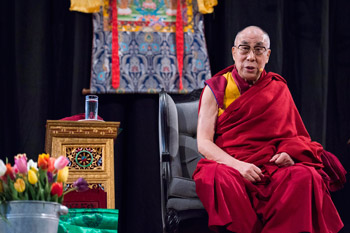
| | His Holiness the Dalai Lama speaking to members of the Tibetan community living in Nordic countries at the church of Laurenskerk in Rotterdam, Holland on May 10, 2014. Photo/Jurjen Donkers |
His Holiness went on to tell the story of a Tibetan and his wife who work in a kitchen in the USA cleaning vegetables. They used to save the caterpillars, worms and other bugs, put them in a jar and later take them outside. Their curious colleagues asked what they were doing and they explained that there was no need to kill these creatures, which also had a right to life. In due course they noticed their colleagues following their example, an instance of Tibetans exercising positive influence on others.
His Holiness also mentioned that some years ago, supporters of the practice of Shugden had staged demonstrations against him, following him wherever he went. Later, some Chinese did this too for a while. The Shugden followers have resumed their demonstrations. They call on the Dalai Lama to stop lying, but, he said, they are the ones who are not telling the truth.
“When one of them raised a question during my public talk, I told him that this is not a new issue. It began at the time of the 5th Dalai Lama. Shugden is said to be a manifestation of Tulku Dragpa Gyaltsen, but the 5th Dalai Lama wrote that he had arisen as a result of distorted prayers as a perfidious spirit. He said as much to a Sakya master from whom he sought help.
“Ling Rinpoche objected to the practice, but Trijang Rinpoche propitiated Shugden. I did so too until 1970 when I began to have doubts about it. I did research into it as a result of which I stopped. When Ganden Jangtse Monastery faced a series of unusual obstacles they consulted Trijang Rinpoche, who told them it was because of the displeasure of the protectors. They asked me how this could be and I investigated and established that the problems related to Shugden. I told the Abbot of Namgyal Monastery who came from Jangtse.
“Shugden supporters set up their own group.
“The 13th Dalai Lama told Phabongka Rinpoche that propitiating Shugden too eagerly risked breaching the precepts for taking refuge in the Three Jewels. This is recorded in Phabongka’s biography. I feel I too have a responsibility to inform people about this, but whether they pay heed is up to them. I’ve never said I banned the practice; I have said it isn’t helpful.
“That’s it. I’m well; be happy.”
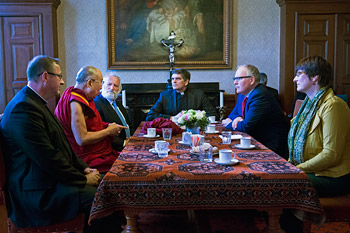 | | His Holiness the Dalai Lama, Rabbi Awraham Soetendorp, Assistant Bishop of Utrecht Monseigneur Herman Woorts, Foreign Minister of The Netherlands Frans Timmermans, and representitive of the Protestant Church in The Netherlands Karin van den Broeke meeting at the church of Jacobuskerk in The Hague, Holland on May 10, 2014. Photo/Jurjen Donkers |
At the conclusion of His Holiness’s talk, Tsering Jhampa and Tseyang Lhazom presented him with a medal to commemorate the 25th anniversary of his having been awarded the Nobel Peace Prize.
Following his meeting with Tibetans, under the auspices of Monseigneur Woorts assistant Bishop of Utrecht, in the company of his old friend Rabbi Soetendorp and others, His Holiness had the opportunity to meet Frans Timmermans, Foreign Minister of The Netherlands and they held a friendly discussion.
Tomorrow, His Holiness will be teaching the ‘Three Principles of the Path’ in the morning and giving a talk about secular ethics in the afternoon.  http://www.dalailama.com/
|